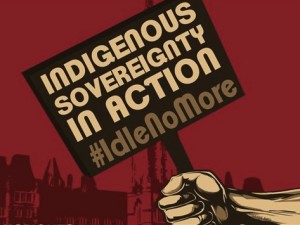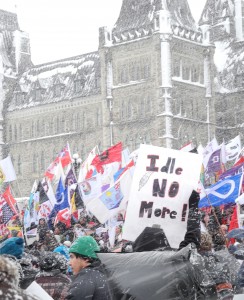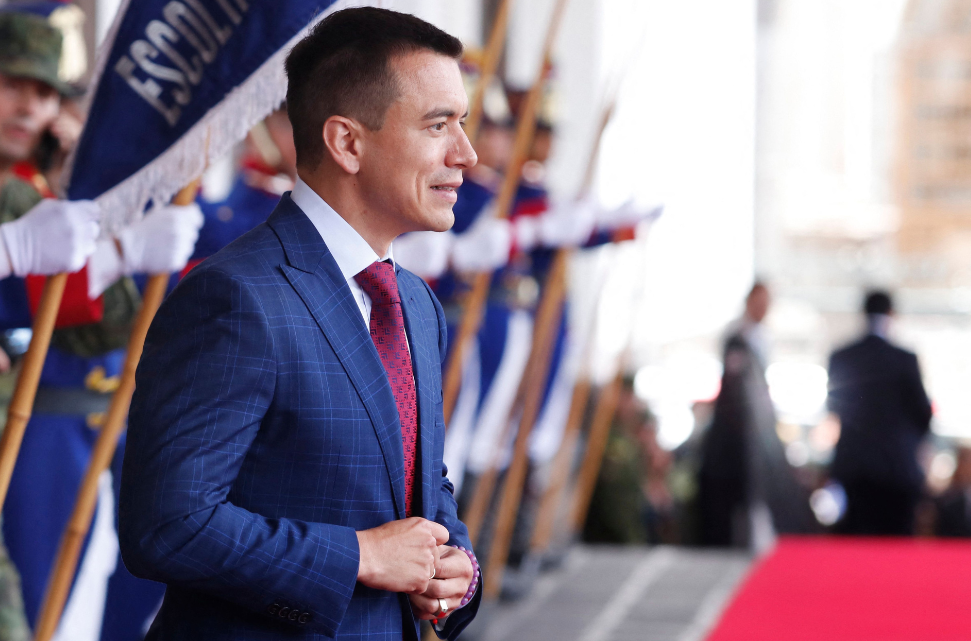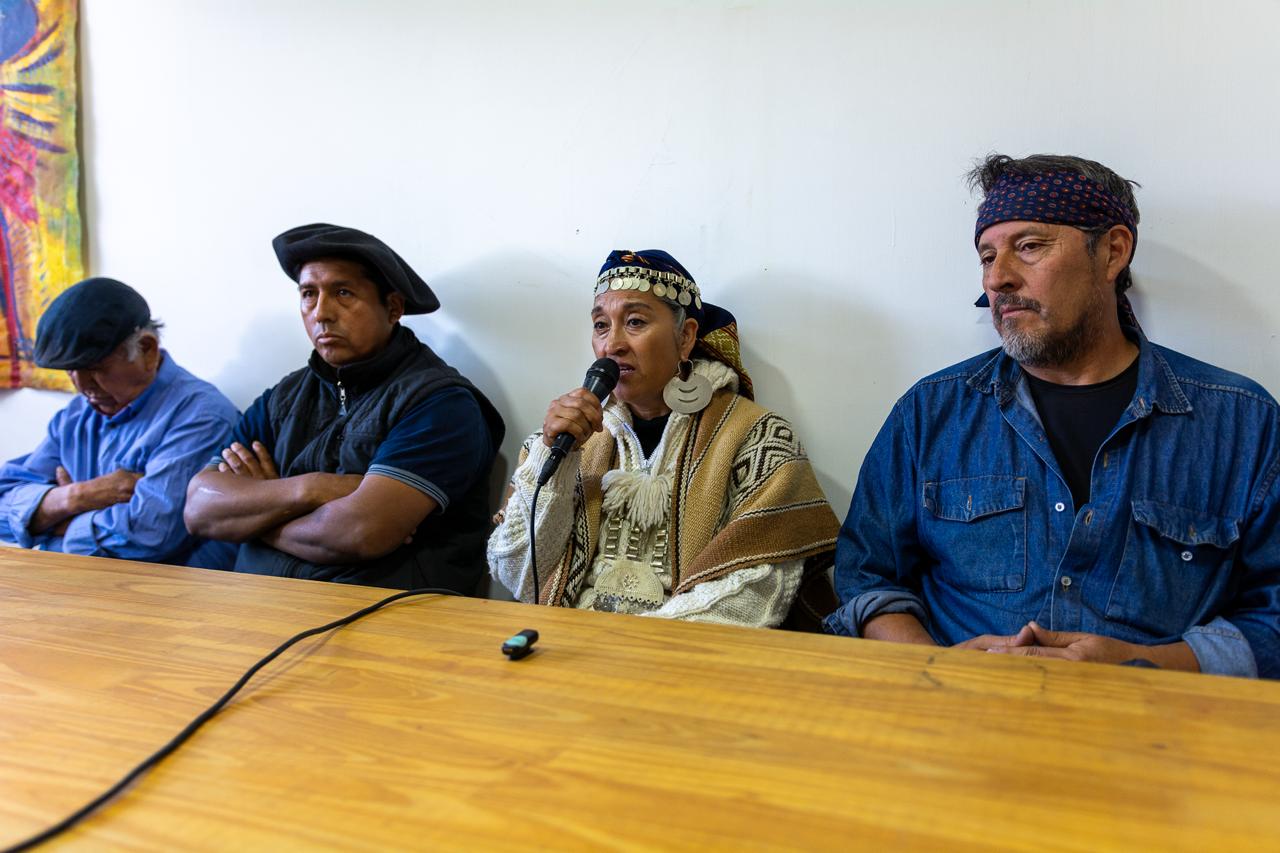 The Idle No More movement is part of a larger Indigenous movement that has been in the making for several years now. Indigenous activists all over the country have been monitoring the political and legal scene in Canada at both the federal and provincial levels and making a concerted effort to help inform First Nation community members and leaders about any potential threats. We noted a clear assimilation agenda that emerged within the Conservative government and we started planning on how we could address that if Prime Minister Harper insisted on putting his plan into action.
The Idle No More movement is part of a larger Indigenous movement that has been in the making for several years now. Indigenous activists all over the country have been monitoring the political and legal scene in Canada at both the federal and provincial levels and making a concerted effort to help inform First Nation community members and leaders about any potential threats. We noted a clear assimilation agenda that emerged within the Conservative government and we started planning on how we could address that if Prime Minister Harper insisted on putting his plan into action.
We of course worked very hard to try all the usual channels to address our growing concerns, which included lobbying, letter-writing, testifying before Senate and Parliament, endless meetings with MPs, Senators, Ministers and others — all to no avail. The Harper government was not interested in talking to us, let alone consulting or getting our consent. Harper decided instead to use the Assembly of First Nations as his primary vehicle to call all the shots. Harper’s government set the agenda, they drafted the joint action plans and they alone decided what was and was not on the table. In other words, Harper managed to bully his assimilation plan onto the First Nation agenda with hardly a squeak of opposition at the political level.
At the so-called Crown-First Nation Gathering (CFNG) last January 2012, Harper promised First Nations his government would not unilaterally amend or repeal the Indian Act. After the CFNG, he broke that promise and proceeded with an aggressive legislative agenda that will include upwards of 14 bills that will devastate our First Nations in various ways. It is the White Paper 2012 with a twist — instead of it being a policy, like the 1969 White Paper, which wanted to assimilate Indians, Harper’s plan will be law. This is the spark that ignited the Idle No More movement into action.
We always knew action would be required at some point, but the legislation posed an imminent threat and required immediate mobilization. That is how a movement was born. In the early days, some were calling the Idle No More movement, some calling it an Indigenous rights movements, but we all agreed that we needed to immediately oppose Harper’s assimilatory legislative agenda. So many of the early activities included teach-ins which helped explain the legislation’s potential impacts on First Nations and more importantly, what we could do to oppose it.
Early protests started out as opposing the massive omnibus Bill C-45, but later came to include the whole suite.
The Idle No More movement, initially started by women, is a peoples’ movement that empowers Indigenous peoples to stand up for their Nations, lands, treaties and sovereignty. This movement is unique because it is purposefully distanced from political and corporate influence. There is no elected leader, no paid Executive Director, and no bureaucracy or hierarchy that determines what any person or First Nation can and can’t do. There are no colonial-based lines imposed on who joins the movement and thus issues around on & off-reserve, status and non-status, treaty and non-treaty, man or woman, elder or youth, chief or citizen does not come into play. This movement is inclusive of all our peoples.
To my mind, the true governing power of our Indigenous Nations has always been exercised through the voice of our peoples. The leaders were traditionally more like spokespeople which represented to views and decisions of the people. In this way, the Idle No More movement, led by grassroots peoples connects very closely to our Indigenous traditional values. But it is not a movement where the people stand alone, their elders, elected leaders and traditional leaders stand with them. This movement is not in competition with any First Nation political organization or elected leaders. This movement is focused on the critical issues before us, not power-struggles, political games or competing for government funding. Everyone so far has donated their time, money, energy and skills to making this work despite the inevitable critiques, push-back and misinformation.
Yet, what makes this peoples’ movement so unique, is also what makes it so difficult for many Canadians and the media to understand. Generally speaking, people understand that each government, group or organization has a leader, a clearly defined hierarchy and rules about who can say and do what. This movement on the other hand, is very organic in nature and first and foremost respects the sovereignty of individual Indigenous peoples and their Nations to participate how and when they choose, if at all. This will mean that some First Nations leaders will choose not to participate, but some of their members will. It could mean one  First Nation community organizes teach-ins whereas First Nations peoples living in urban areas will get together and organize flash mob round dances.
First Nation community organizes teach-ins whereas First Nations peoples living in urban areas will get together and organize flash mob round dances.
Think of the many ways in which this movement has already developed. We had teach-ins at Louis Bull, Saddle Lake and other First Nations. We have posted information, publications and videos online for all to access. We have engaged the media to help educate the public about why this impacts them as well. The Chiefs organized a protest during the AFN assembly to oppose the legislation (including Bill C-45). Chief Spence is on a hunger strike standing up for all First Nations and the treaty relationship, which Canada has forgotten. Kids in schools have held Idle No More Rallies and there have been marches, protests and temporary traffic and railways slow downs. The core unifying theme to all of it has been that they are peaceful activities meant to help educate Canadians about how this is in all our interests.
We do have structure, we are organized, we work very closely with one another across the country to strategize and we are growing. We have worked with active First Nation leaders on the ground since the very beginning and many of us continue to do so. Our allies increase every day as more and more organizations are joining the movement. Now we have widespread international support which also grows everyday. Pretty soon you will see more and more prominent figures stand up to put pressure on Canada to come to the table in a real, meaningful way.
To me, Idle No More is a responsibility — a responsibility to live up to the sacrifices of our ancestors, to the duty we have as guardians of the earth, and to the expectations that our children and grandchildren have of us to protect them. Every single one of us has that responsibility, though, at any given time, we all have different capacities, skills and opportunities in which to fulfill it. Regardless of our situation, I believe that we all carry that responsibility from the very moment the Creator blesses us with our first breath until our last.
This responsibility means that it is not good enough to work hard, get an education, find a job, and provide for one’s family. These are important things, and our ancestors did their best to ensure that we would have a prosperous future. Many even negotiated these provisions in some of our treaties. But, it is not good enough for us to simply be comfortable, at least not as long as we have brothers, sisters and community members who live without food, water or housing. Right now, many of our Indigenous peoples are facing multiple, overlapping crises that require emergency attention. The very grassroots people standing on the front lines of this movement are there because they are the ones without clean water, housing or sanitation and the politicians have done little to address this.
This movement is set apart from any other before it. Unlike the Occupy movement, this movement involves peoples with shared histories, experiences, goals and aspirations. We as Indigenous peoples are all related, we all care about each other’s futures and we share the same responsibility to protect our rights, cultures and identities for our seventh generation. This movement also has a special spiritual significance in that this was prophesied – that the seventh generation would rise and restore the strength of our Nations, bring balance and see that justice was restored to our peoples.
This movement is also unique in that it includes Canadians as our allies. Just as the early days of contact when the settlers needed our help to survive the harsh winter months, and seek out a new life here, Canadians once again need our help. They need our help to stop Harper’s destructive environmental agenda. First Nations represent Canadians last best hope at stopping Harper from unfettered mass destruction of our shared lands, waters, plants and animals in the name of resource development for export to foreign countries like China. Why? Because only First Nations have constitutionally protected Aboriginal and treaty rights which mandate Canada to obtain the consent of First Nations prior to acting. These rights are also protected at the international level with the United Nations Declaration on the Rights of Indigenous Peoples.
When First Nations organize in Idle No More to oppose this legislation, they do so to protect all of our interests – First Nation and Canadian alike. The most precious resources in the near future will be farmable lands and drinkable water. If there is no clean water, this impacts everyone. We are standing up not only to protect our lands and waters, but we are also standing up to restore justice for First Nations and democracy for Canadians. We can work together to defeat this threat to Canada and find a way to share the lands and resources as the treaties envisioned.
When asked what do we want, that question can be answered in two parts:
(1) In the short term, Canada must withdraw the suite of legislation impacting First Nations, amend those omnibus bills which threaten our lands and waters, and restore the funding that was cut to our First Nation advocacy organizations and communities;
(2) In the long term, Canada must set up a Nation to Nation process whereby First Nations and Canada can address many of the long outstanding issues related to the implementation of treaties and sharing the lands and resources.
Ultimately, we want to be free – free to govern ourselves as we choose; free to enjoy our identities, cultures, languages and traditions – i.e., to live the good life as we see fit. This means Canada must respect our sovereignty and get out of the business of managing our lives. Given that Canada has worked hard to put us in the situation we are in, Harper will have to come to table with some good faith and offer some solutions to address the current crisis facing many of our communities in relation to the basic essentials of life – water, sanitation, housing, and education. If Harper can do no more than appear at a meeting on January 24th as requested by the AFN, our most vulnerable citizens will not see justice.
What Idle No More means to me is the coming together of Indigenous peoples from all over Turtle Island to work together to restore pride in our peoples, to stand up for our rights and live up to those responsibilities we have to one another and Mother Earth.
It is inspiring hope, when many had lost hope that anyone would ever stand on their behalf.
It has inspired pride in who we are as Indigenous peoples because our peoples and the ways of our peoples are beautiful and something to be cherished and defended.
It has inspired leadership in those who thought they had nothing left to offer their Nations.
It has inspired a reconnection of youth to elders, citizens to leaders and men to stand beside their women.
It has inspired the most oppressed peoples to stand up and exercise their voices.
We are alive again and the spirits of our ancestors are walking with us on this journey.
I believe in the power of our peoples — we can do this!
Dr. Pamela D. Palmater is a Mi’kmaw lawyer and member of the Eel River Bar First Nation in New Brunswick. She teaches Indigenous law, politics and governance at Ryerson University and heads their Centre for Indigenous Governance. She is an organizer and spokesperson for the Idle No More Movement. This article was originally published by Rabble Jan. 4, 2013.
For More Information:
Al-Jazeera Panel on Idle No More
“Idle No More’s Ultimate Goal?” Pamela Palmater on CBC’s Power and Politics, Jan. 2, 2013.
“Idle No More Protests Block Trains” CTV News
‘When Legislators Make Bad Law: Bill C-3’s Assault on Democracy’
Presentation on Legislation (Part 1, Part 2, Part 3, Part 4)
Pamela Palmater, “Why We Are Idle No More”, Ottawa Citizen, Dec. 28, 2012
Pamela Palmater, presentation on Legislation (Part 1, Part 2, Part 3, Part 4) (audios)
Photos: Jen Moore. Graphic: Rabble



